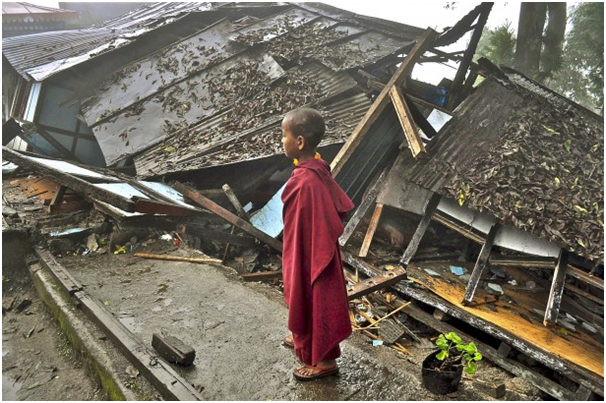N-E Faces High Earthquake Rise: Experts
File photograph of earthquake damage in Sikkim

NEW DELHI: Environmental and security experts have predicted a severe round of tremors in the North eastern region of India in the coming weeks.
The National Disaster Management Authority (NDMA) has attributed the increase in earthquake risk in the region due to a spurt in developmental activities driven by urbanization, economic development and globalization. According to the NDMA, loss of human life is no longer the sole determinant of earthquake risk.
It has warned of long-term adverse consequences including huge economic losses triggered off by earthquakes, which in turn would cause the local or regional economy to collapse. While Imphal does not have too many high rise buildings and continues to respect heritage structures built over 100 years ago, other state capitals in the region – with the other exception of Agartala – have all witnessed haphazard increase in the number of multi-storeyed buildings in the past two decades.
Landslides triggered off by heavy rains have become regular feature in most of these cities. Monday’s tremor could be only another warning for both – the authorities and citizens – to wake up to reality.
Speaking to The Citizen, the Additional Director General (Media and Communications) Kuldeep Singh Dhatwalia said, “We are observing the situation. The preparations have also been put in place. We are also following the observations of the experts. NDMA has been put on job and a continuous monitoring is going on. The natural disaster need to be tackled with readiness and we are focusing on preparedness”.
Monday morning’s tremor measuring 6.7 on the Richter scale that rocked the whole of north-eastern India and claimed at least eight lives, has one again brought into focus the high seismicity of the region which is even otherwise highly prone to various kinds of natural calamities including floods, river-bank erosion, landslides and forest fires.
The North-east is located in Zone V – “very severe intensity zone” – and covers about 12 per cent of the country’s total geographical area and about 11 per cent of the population. With the adjoining countries of Nepal, Bangladesh, Bhutan, China and Bangladesh sharing space in Zone V, what the North-east requires is a very well-drawn up disaster preparedness plan, apart from a detailed disaster mitigation policy comprising very strict construction by-laws.
The region has experienced at least 18 severe earthquakes measuring above 7 on the Richter scale in the last 100 years. These include the ones that struck Shillong (1897) and Assam-Arunachal-Tibet (1950), with the latter changing the course of many rivers including the Brahmaputra. The devastation caused by the Sikkim earthquake of 2011 is indicator of what is in store for the region in terms of seismic activities and their impact. Needless to say, the high seismicity of the region is due to the collision tectonic between the Indian and Eurasian plates in the north and the tectonic movement along the Indo-Myanmar boundary.



